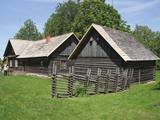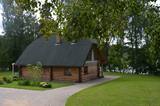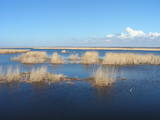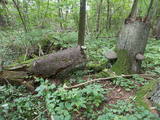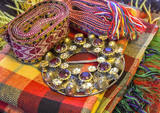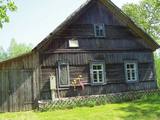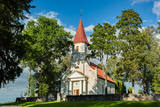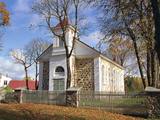| Nr | Name | Beschreibung |
|---|---|---|
|
St Peter’s is one of the oldest historical monuments in the Baltic States, and it is also the best place from which to survey the historical centre of Rīga, which is part of the UNESCO list of world cultural heritage. You can see the central part of Old Rīga, City Hall Square, the Pārdaugava region on the opposite side of the river, and even – during clear weather – the Bay of Rīga. The tower of the church is 123 metres high, but the viewing location is at a height of 72 metres.
|
||
|
The castle hill of Milka is situated near Lake Sālaja and River Malta; 27m above the lake level. Local
businessman cleaned the hill and placed the statue of Mother of God there. It is a a symbol of Latgalian
strong faith into God and Virgin Mary.
|
||
|
Die Windmühle ist von 1867 bis 1869 im holländischen Stil gebaut worden. Der Namen erwarb die Windmühle nach dem Familienname des ersten Besitzers – Riba. Die Windmühle ist eins der besser erhaltenen Architekturdenkmäler dieser Typs in Lettland. Auf der Windmühle ist die dauerhafte Exposition “Der Weg vom Getreide” errichtet, die über landwirtschaftliche Entwicklung in Semgallen, die Traditionen der Getreidezucht und des Brotbackens erzählt. Es werden Exkursionen mit Guidebegleitung angeboten. Die Windmühle gehört zum Erholungskomplex (Hotel, Restaurant, Mühle) „Rožmalas”. |
||
|
Gas mixture is the main raw material for Estonia’s energy and chemical industries, and it is extracted in our day from open quarries or underground shafts. This layer was established during the Ordovician Period between 450 and 480 million years ago, and it is made up of the remnants of plants and animals from that age. In the Kohtla-Nõmme suburb, there is a shaft which can be toured in the company of a guide who will tell you that this is the only layer of its kind in the Baltic States. He will tell you about how the gas mixture has been extracted over the course of history.
|
||
|
The Museum of Francis Trasuns „Kolnasāta”. The museum of the promoter of Latgalian revival,
prominent cultural worker, pastor and politician F. Trasuns (1864 – 1926) was established in his house „Kolnasāta”. There is also an exposition about Jānis Klīdzējs; a collection of old household items. „Kolnasāta”
is the place of many cultural events in Latgale.
Working hours: Mon– Fri : 8.00 - 16.00, Sat., Sunday : on request |
||
|
The holiday houses are located near Lake Ieva, 30 m from the lake shore. On the 1st floor of the holiday house - lounge with fireplace and glazed veranda, sauna (50.00 EUR / evening), small kitchenette, toilet. Outside-small terrace overlooking the lake. On the 2nd floor there are 2 isolated rooms and 10 beds. By the lake - a fireplace, a well-groomed swimming area with a footbridge. Boats and catamarans can be rented. |
||
|
Die Inhaber erzählen und zeigen, wie aus Ton die verschiedenen Erzeugnisse entstehen. Die Besucher können sich auch selbst beim Töpfern versuchen. Vorrätige Produkte kann man erwerben oder auch neue bestellen. |
||
|
Das ist ein flacher, lagunenartiger See, der mit dem ihn umgebenden Feuchtgebiet von internationaler Bedeutung ist. 271 Vogelarten wurden in diesem Gebiet gezählt, einschließlich 43 Vogelarten, die in der Lettischen Roten Liste aufgeführt sind und 15 aus der Europäischen Roten Liste. Zum Park gehören das Nida-Moor und der Teil des Meeres, das sich längsseits des Parks befindet. Zwischen dem Pape-See und der Ostsee befindet sich Lettlands älteste Vogelberingungsstation, wo nicht nur Vögel beringt werden, sondern auch Fledermäuse. Der Pape-See ist das erste Territorium in Lettland, wo Rückzüchtungen von Wildtieren ausgewildert wurden, um die überschwemmten Wiesen des Sees sachgerecht verwalten zu können. Zuerst waren es Wildpferde (Konik-Pferde), dann Auerochsen und der europäische Bison. Durch den Pape-See führt auch Lettlands einzige markierte Wassertourismusroute. Besucher können Vogel- und Naturbeobachtungstürme nutzen, Naturpfade usw. Das Dorf Ķoņi ist ein einzigartiges Beispiel für ein am Meer gelegenes Fischerdorf. Der Pape-See ist unter den Vogelbeobachtern beliebt. Das Besucherzentrum wurde im “Haus der Natur “ des WWF eingerichtet.
|
||
|
Dabas liegums veidots ainaviskā Kāla ezera trīs salu (Tolkas, Lielā Vestienas un Vistu sala) un to mežu biotopu aizsardzībai. Diemžēl, salu apmeklētāji (makšķernieki?) aiz sevis ir atstājuši ne tikai nelabiekārtotas apmetņu un ugunskuru vietas, bet arī atkritumus. Tā kā salu vērtību spēs novērtēt tikai zinošs speciālists, ieteicams dabas liegumu vērot no skaistajiem un pauguriem klātajiem Kāla ezera ziemeļu un austrumu krastiem. Teritorija atrodas Vestienas aizsargājamo ainavu apvidū.
|
||
|
Z/s "Kaupēni" ir ieguvusi bioloģiskās saimniecības statusu. Kaupēnu saimnieks Valdis Apalups ir pievērsies kazu audzēšanai, gaļai - saimniecībā uz vietas notiek arī gaļas pārstrāde. |
||
|
Features vivid woven Suiti textiles and offers master's classes. You can also purchase souvenirs. Contact the workshop in advance if you want to take part in the classes. |
||
|
The House-Museum of the writer Michael Narics. Reveal the history of political repressions in the
USSR and Soviet Latvia; see creative works of the winners of competition organized by M. Narics Educational
Center.
Working hours: on request |
||
|
Neliels, bet ļoti ainavisks un ar lieliem laukakmeņiem klāts
zemesrags. No raga iztālēm redzamas Veczemju
klintis.
|
||
|
Pastāv uzskats, ka tieši Rubenē izveidojusies pirmā latviešu draudze. Baznīcas altārdaļa būvēta jau 14.gs., bet pati baznīca savu pašreizējo izskatu ieguvusi 1739. gadā.Būtiska baznīcas interjera sastāvdaļa ir Ķieģeļu muižas mantinieces Barbaras Helēnas fon Budbergas 1762. gadā dāvinātais kroņlukturis ar Krievijas impērijas divgalvaino ērgli un zaru ornamentiem uz bumbas. Baznīcā redzama arī zīme (1869. g.), kas ir veltīta pusgadsimtam kopš dzimtbūšanas atcelšanas. Pastāv vairākas teikas par Rubenes baznīcas nosaukuma rašanos. Viena no tām vēsta, ka, sargājot baznīcu no velna, tās sienā iemūrēta sieviete un vīrietis, kura vārds bijis Rubens. Baznīca esot nosaukta viņam par godu.Vēl viena versija vēsta, ka baznīcas nosaukums cēlies no rubeņa, kas sēdējis kādā no kokiem, kas vēlāk izmantots baznīcas celtniecībā. |
||
|
Alle Mitglieder der arbeitsamen Bauernfamilie produziert Räucherschinken und bäckt Brot. Das Fleisch wird nach den örtlichen Rezepten im selbstgebauten Räucherofen geräuchert, der dem Fleisch einen besonderen Rauchgeschmack verleiht. Das Brot wird aus qualitativen Vollkornroggenmehl gebacken. Brot und Schinken kann man freitags kaufen. |
||
|
After the death of the Kalnasikšņi oak tree, which was the mightiest tree in the Gauja National Park, the mighty Kvēpene oak tree has taken over that role. It has a circumference of 6.1 m, a height of 20 m, and a crown which measures 28 x 30 m. The beautiful tree is on the right bank of the Gauja River valley and is one of the most excellent trees in Latvia. Near it is the forested Kvēpene castle hill, as is the Svētavots stream, which is reputed to have medicinal waters. To the North of the castle hill is the Rūsiņš hillock, which offers a good view of the surrounding forests, the towers of the city of Cēsis, Ieriķi, and the Rakšupe estuary at the Gauja. There is a bench at the top of the hillock from which lovely sunsets can be seen. |
||
|
St. John the Baptist Roman Catholic Church of Nagļi was built
in 1862 by landlord Nābels. Some time ago, Nagļi Church was a branch of Viļāni Church. The Bernardian
monks served there. After the closing of the cloisters in 1930s, the church was served by priests.
|
||
|
Tour groups with at least ten people can enjoy tastings of various homemade wines (23 types in all) that are made of fruits and berries – three types of wine each time. The owner will tell you about winemaking technologies and ways to drink and enjoy wine. |
||
|
Der Name von Subate ist zum ersten Mal im Jahr 1570 erwähnt worden, als der kurländische Herzog Kettler dem Grafen G. Plater-Sieberg den Platz des Marktes verkauft hat. Als im 17. Jh. die Familie Plater-Sieberg zum katholischen Glauben übergegangen ist, protestierten die evangelisch-lutherischen Einwohner von Subate und sind zum östlichen Ufer des Sees von Subate umgezogen, der das Eigentum der Familie von Osten-Sacken war, der auch das Landgut von Prode (heute nur Ruinen) gehörte. Im Jahr 1685 hat die Familie von Osten-Sacken den Überläufern eine evangelisch-lutherische Kirche gebaut, um die sich die Ortschaft Jaunsubate herausbildet hat. Beide Stadtteile wurden im Jahr 1894 vereint. Während der Freiheitskämpfe im Jahr 1919 wurde Subate von Litauern befreit, danach folgte die Teilung der Stadt zwischen Lettland und Litauen (im Jahr 1921 wurde die Grenze auf der ehemaligen Linie festgelegt). Das historische Zentrum von Subate bildete sichvom 16. bis 19. Jh. heraus. In dem Zentrum kann man Gotteshäuser von vier verschiedenen Konfessionen und eine Bebauung aus kleinen Holzhäusern besichtigen, die sich am Rand von schmalen und sich windelnden Straßen befinden. Die Stadt liegt an den Ufern einer subglazialen Bettung, in der sich auch die Seen Lielais Subates ezers und Mazais Subates ezers befinden, darum bieten auch die Naturverhältnisse der Stadt einen für Lettland nicht charakteristischen Blickwinkel. |
||
|
Ein Abschnitt der Schmalspurbahnlinie mit Spurbreite 750 mm, der Alūksne un Gulbene verbindet ist in Teil der ehemaligen Eisenbahnlinie Stukmaņi – Valka. Zurzeit ist es die einzige Schmalspurbahn mit ständigem Personenverkehr in Lettland, die noch im Betrieb ist. Die Bānītis fährt jeden Tag. Ein im Südteil der Stadt Alūksne gebautes Stationsgebäude wurde 1903 eröffnet. Die Linie ist 33 km lang und hat 10 Stationen und Haltepunkte. Die Fahrt mit der Bānītis dauert ~ eineinhalb Stunden. Populär ist ein jährliches Fest der Schmalspurbahn Alūksne – Gulbene, zu dem viele Gäste kommen. |
||




